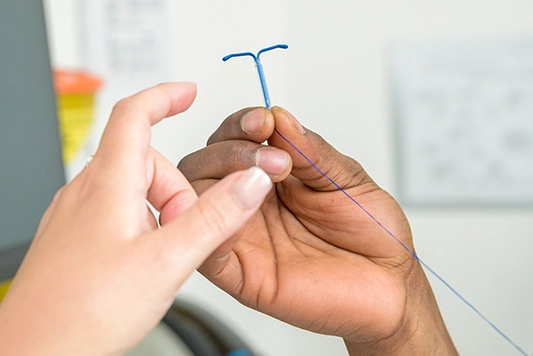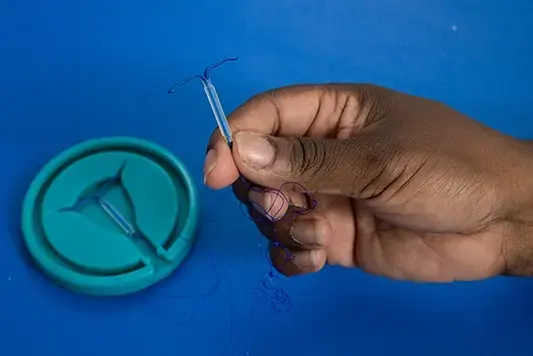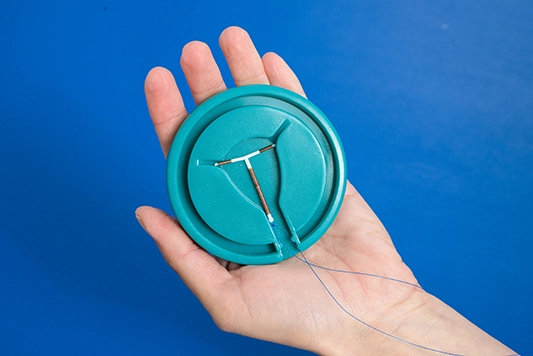Long-acting contraceptive methods

LARC methods: the gold standard of the contraception world
LARC stands for long-acting reversible contraception, such as the implant, coils and injection: once they’re fitted you can forget about them.
These methods are fantastic because not only are they the most effective and they don’t interrupt sex, but they also are reversible so, if you want to, you can plan a future pregnancy at a time that’s right for you.
Long-acting reversible contraceptive methods
Long-acting reversible contraceptive (LARC) methods offer excellent protection against pregnancy, ranging from three months up to ten years.
They’re ideal if you know that you do not want to have children for a while. In fact, once in place, you don’t need to think about these methods until they need replacing, and none of them interrupt sex.
Scroll down for more detailed information on long-acting reversible contraceptive methods.

Types of long-acting reversible contraception
The implant is a small plastic tube that is about 4cm long and is inserted under the skin in your upper arm. The implant releases a hormone which stops the ovaries from releasing an egg.
The implant prevents pregnancy for up to three years, and is more than 99% effective with perfect use.
Fewer than 1 in 100 people using the implant will get pregnant in a year.
The implant is safe to use for as long as you need, and your fertility will return to normal when it is taken out. It is suitable for those who can’t use contraception with oestrogen in it.
The implant is inserted into your arm, which may be sore or swollen for a few days. You may experience some side effects, and the implant may affect your periods. If your bleeding pattern is unacceptable this can usually managed by your GP.
Follow this link to read more about the contraceptive implant and watch a video explainer.
We offer two types of coil at MSI UK: a hormonal coil and a non-hormonal coil.
The hormonal coil (also known as the LNG-IUD, and formerly known as the IUS) is a small T-shaped plastic device inserted into your uterus. It releases progestogen to prevent pregnancy for 3-8 years.
The hormonal coil is more than 99% effective at preventing pregnancy, and you don’t have to think about contraception for up to 8 years.
Fewer than 1 in 100 people will get pregnant over the 3 to 8 years when using a hormonal coil.
This method is suitable for those who cannot use contraception containing oestrogen, and once removed your fertility will return to normal.
It is common to experience bleeding or spotting in the first six months after having the hormonal coil fitted, but after that your periods may become irregular, lighter, or stop altogether. This makes the hormonal coil a very good choice for those who experience heavy or painful periods.
Follow this link to read more about the hormonal coil and watch a video explainer.
Also known as the ‘copper coil’ or CU-IUD, a non-hormonal coil is a small copper and plastic T-shaped device that is inserted into the uterus. It releases copper, which prevents pregnancy by stopping the sperm and eggs surviving in the womb.
The non-hormonal coil can remain in place for 5-10 years and is more than 99% effective.
Fewer than 1 in 100 people will get pregnant in a year, depending on the type of non-hormonal coil.
The non-hormonal coil is suitable for most people, including if you are breastfeeding or unable to use hormonal methods of contraception. Once removed, your normal fertility will return straightaway. The non-hormonal coil is very popular amongst those who dislike hormonal methods of contraception.
Follow this link to read more about the non-hormonal coil and watch a video explainer.
There are two types of the contraceptive injection, Depo-Provera is given in the muscle in the bottom and the Sayana Press is self-administered beneath the skin in your tummy or top of the thigh and you can be taught to do this yourself.
They both contain the hormone progestogen, which is released into your blood to prevent pregnancy. The injection lasts up to 13 weeks at a time.
The injection can be given at any time during your menstrual cycle, and is more than 99% effective with perfect use. Fewer than 1 in 100 people using the injection will get pregnant in a year when using contraceptive injections regularly. The injection is 94% effective with typical use. Around 6 in 100 people will get pregnant in a year.
It can be used while breastfeeding, and is also suitable if you can’t use oestrogens. Your periods will probably be affected by the injection, and may stop altogether. Those who suffer from heavy or painful periods often like this method. Your fertility will return to normal but periods could be delayed for up to 18 months after stopping the injection.
Follow this link to read more about the contraceptive injection and watch a video explainer.

Which method is right for me?
Find a contraception comparison tool that can help you find the right method for you.

Short-acting contraception
Short-acting methods include the contraceptive pill, patch and ring.

Barrier methods
Barrier methods include condoms, diaphragms and caps.




